Smells like North Texas: Inside our corner of the niche perfume world
ArtandSeek.net October 6, 2021 268Niche perfumes aren’t like your traditional Chanel number 5s or Polo Ralph Lauren. They have names like Milk Wasted and Last Exit For The Lost. And with scent notes of fresh dirt and motor oil, they aren’t for everybody.
From a favorite dish soap to the iconic bouquet of luxury brands, most scents are created by one of five top fragrance houses. Their perfumers often study in France, and their scents are designed to follow popular trends and appeal to the masses. Niche fragrances aren’t associated with any major house. They’re the work of artists drawing from their personal experiences.
And they’re big business. The Financial Review reported that niche fragrances took up 10% of the fragrance market in 2019. In 2020, a market research company found niche fragrances were outperforming traditional fragrances, despite COVID. Millennials and Gen Z are searching for more unique personal scents, fueling their popularity.
In her podcast Articles of Interest, Avery Trufelman compared fragrance to music, with the big perfume houses producing pop, and indie perfumers creating everything else.
“Thousands of independent perfumers have started popping up. Many of them taking artistic risks that a designer brand wouldn’t dare attempt,” Trufelman said. “There are hardcore boutiques … scattered around the world, and they almost act like oddball record shops for the underground music nerds who want to sniff the strange stuff.”
Here’s a look at some of the niche and indie perfumers of North Texas and the community of collectors and sellers that support them.
Perfumers
SIXTEEN92
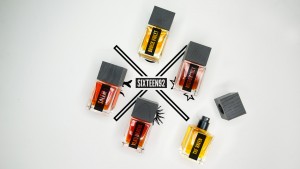
Photo: Claire Baxter
East Dallas native Claire Baxter started Sixteen92 in Fort Worth, after working in luxury advertising. For eight years, she has created themed collections of perfumes based on literature, history, lore, and music. Her themes range from banned books to ’90s girl rock.

Photo: Ryan Baxter
“I’m like the fragrance version of a method actor,” Baxter said. So I kind of immerse myself in whatever concept it is that I’m trying to capture, and for hours or however long it is, I’ll just think of nothing but that concept and build a piece around that feeling.
“It’s fun to take little pieces of my life and translate them into fragrance and in that way they can take on their own life and start to inspire other people to create their own memories.”
Baxter’s work can sometimes be wildly conceptual. Her perfume The Bottling Room is her version of what someone who had never smelled a flower would think a flower smelled like. (Hint: glass and electricity.) These unique scent blends have earned her praise, and she even won the artisan category in 2017 Art + Olfaction Awards for her perfume Bruise Violet. As an artist, it is rewarding to explore more complicated stories, she said.
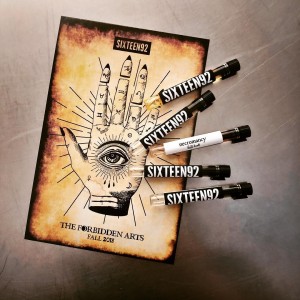
Photo: Claire Baxter
“It’s always easy to make something that smells like strawberry milkshakes and flowers, and not that there’s anything wrong with that. I enjoy them just like everybody else enjoys them,” said Baxter.
“But, sometimes it’s cathartic to relive those really specific and kind of challenging memories from childhood that left an impression on you, even if the memory itself seems kind of bland,” Baxter said. “You know, smelling the tomato garden after a rainstorm, laying in the swimming pool looking up at the stars, you know, those weird little snippets of memory that you have and creating an atmosphere around that.”
She conceded that she isn’t sure who, besides her, wants to smell like a tomato garden after a rainstorm. But she does think that nontraditional art is popular.
“The non-conformist ideals for art, individuality, and expression are just kind of universal at this point, and it’s becoming a little bit more expected and OK to express who you are, even if that is maybe a little weird or uncomfortable,” Baxter said. “I think it’s awesome. Though not everybody wants to smell like a department store. Sometimes you do and sometimes you don’t. So it’s good to have that option.”
KHEIMISTRI
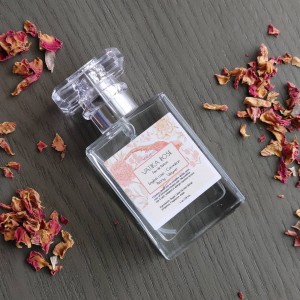
Photo: Kheimberli Hardeman
Kheimberli Hardeman owns Kheimistrii, an online shop based in Fort Worth. She sells fragrances inspired by everyday moments, from a baby’s milk-drunk face to her friends’ tales of modern dating.
“With each fragrance, I try to create to recreate the moment I was feeling when I actually created the product, so when people apply it, I want them to feel that moment, and I want them to relate to it,” Hardeman said.
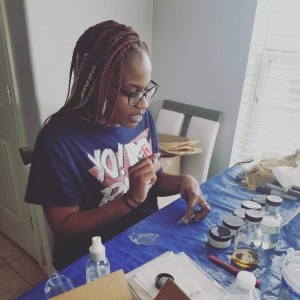
Kheimberli’s daughter helps pack her products. Photo: Kheimberli Hardeman
“I want them to look at the description and be like: hey I remember when… And then, if they’re not exactly feeling my moment, it evokes a memory for them, and they’re passionate about it.”
Hardeman uses fragrance to gift special moments from her life. She calls her customers her supporters because they aren’t just purchasing her products, they are supporting her art. She says that the connection between the fragrance makers and collectors is closer between indie perfumers than between traditional perfumers.
“Our fragrances are built from personal experiences. They’re built from love. They’re built from family gatherings, from friends, so it’s more personal,” Hardeman said.
“People want to be our supporters. They do want to be a part of our world and we’re right there because we’re all about people. Most of us are introverts. We have major anxiety and things like that, so this helps us and it also helps people that are just like us, and that’s the type of community we create.”
HAGROOT
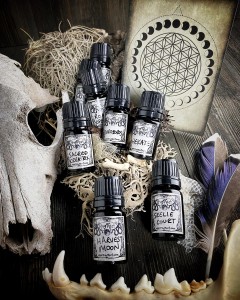
Photo: HagRoot
Granberry perfumer HagRoot grew up as a Jehovah’s Witness. At age 12, she left the church and began exploring nature-based religions. Her knowledge of religions and folklore inspire her fragrances. And making fragrance is a spiritual practice for her.
“It’s more a feeling than it is words,” HagRoot said. “It just transports me to other places. It opens me up in ways where sometimes when I’m working with fragrance, I’ll get visions and stuff and a lot of the time I feel kind of guided through what I’m working on.”
Her fragrance names, like the Bone Witch and Circe, come from trances she’s experienced. She said she feels deities’ energy flow through her while she crafts a scent.
“Sometimes I’m extremely surprised by what winds up coming through because it’s something that I would not have chosen,” HagRoot said. “But then, once it’s finalized and it has had time to sit, and then I go back and smell it, it’s just like: yes, the energy in this bottle is exactly the energy of that deity or whatever energy it is that I was trying to work with, that’s exactly what it should be.”

Photo: HagRoot
HagRoot began making fragrances in 2010, after an indie fragrance maker she liked went out of business. She’s held different jobs, but her fragrance business has been a constant. She also sells her mixed media art and spiritual items on her website. She does advertise some of her fragrances as “ritual oils,” but once she creates a fragrance, she has no expectations about how customers use it.
“I know with my perfumes and oils personally, they speak to people.” She gets notes from customers about the intense relationship they have with her fragrances. It can be confusing, but her mother and husband reassure her.
“They’re like, well maybe it’s not for you to understand or get, just keep putting out what you feel called to put out, and people will keep responding how they do.”
Collectors
NATALIE MCCURLEY
Denton’s Natalie McCurley has a collection of 70 to 80 perfumes, from full-size bottles to smaller rollerballs.

Photo: Natalie McCurley
Her relationship with perfume began in middle school, with sprays from Bath and Body Works. As she got older, fragrance became a way to express her changing identity. She got a darker, more edgy and sophisticated perfume when she felt like she was coming into her own as an adult. She wears a perfume that smells like book-binding glue and dusty pages when she wants to feel comforted. McCurley sees fragrance as a form of self-expression, like fashion, but more potent.
“It’s almost like taking something into a fourth dimension because if you follow fashion or style or whatever, there’s always that visual element, but I think fragrances almost something that can just push it over the top because it is that other dimension, that’s not just visual,” McCurley said.
“You can walk into a room and like, your perfume can still be there after you leave. It can stick with people.”
McCurley collects both traditional and niche fragrances, although she admits there is an appeal to having a unique scent in a room full of people wearing Coco Chanel. McCurley enjoys connecting with other fragrance collectors.
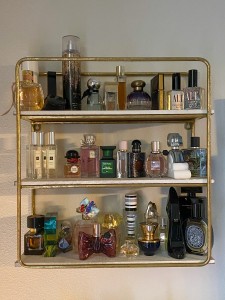
Natalie McCurley’s collection of niche and indie perfumes.
“I really like reading other people’s reviews because they can really go into what it means to them,” McCurley said. “It’s cool to see into other people’s minds about why they bought something or why they love something.”
Niche perfumes range in price, from $10 or $20 to hundreds of dollars for a bottle. To some, collecting perfume may seem like a luxury hobby. But if you’re interested in fragrance, you shouldn’t let money stop you, McCurley said. There are ways to collect even the most expensive scents, from getting samples at stores to looking for fragrance dupes on forums. Other advice: Don’t buy a fragrance just to follow a trend.
“I don’t think it’s something that you have to do,” McCurley said. “I think that if you are drawn to it and you enjoy it, then just do it because you like it and not because of whatever reason someone could come up with.”
Sellers
Some department and beauty stores are beginning to stock the more popular niche fragrances. But most are available only online or in a handful of boutiques scattered across the globe.
Dallas is unique for a city of its size to have one of these boutiques.
The Scent Room carries around 500 niche perfumes, primarily from European perfumers. According to their website, their founder Deborah Turner visited a niche fragrance boutique during a vacation to Italy in a quest to find a new unique scent and was so enraptured by the store that after her vacation she began the process of creating The Scent Room.
However, most indie fragrances are sold online, where, of course, you can’t smell them. So the descriptions and stories surrounding them can make or break a perfume. For Baxter, writing descriptions of her fragrances is her favorite part of the process and the hardest.
“How do you explain what something smells like?” Baxter asked. “I mean really think about it. It’s impossible, right? You can relate it to experiences that are likely to be shared and that’s about the best you can do, really.”
Fragrance is incredibly subjective. Our olfactory bulb, or the part of our brain that processes smell, is part of the limbic system, which processes our emotions and retains memories. We have all evolved to avoid certain scents, but the ones we like are more subject to trends and personal experience. From your mother’s perfume to rotten fruit, humans are wired to have a visceral experience with scent.
Tapping into the visceral experience that fragrance evokes is what elevates making perfume to an art form.
“I really do think that there is something about it just tapping into an emotional side, and I think that’s what art in general does. You know?” McCurley said. “It’s beyond just you smelling something and having a pleasant experience. It can just resonate more deeply.”










